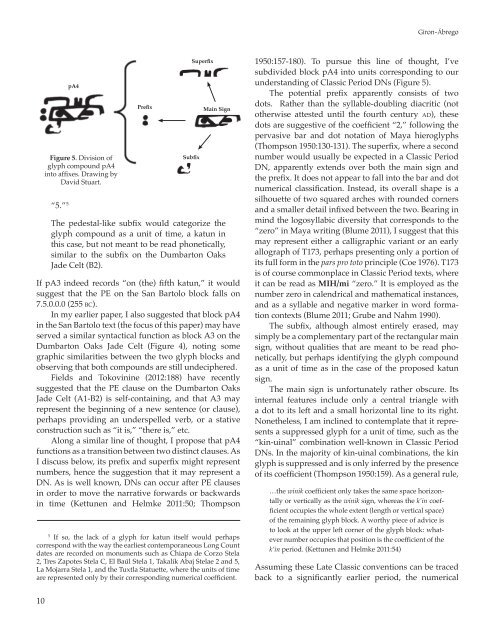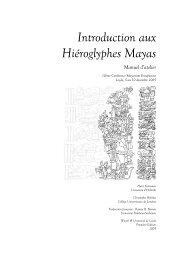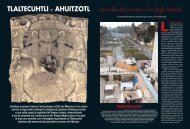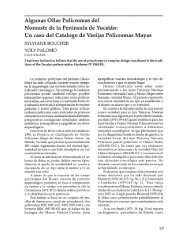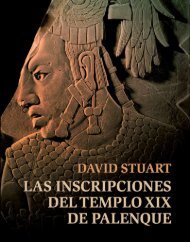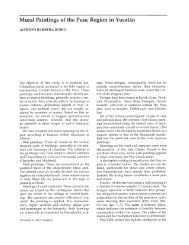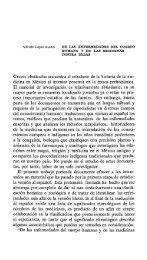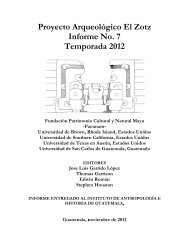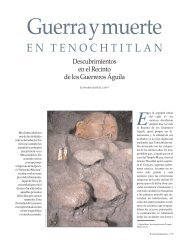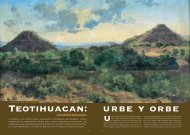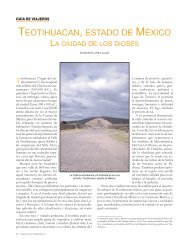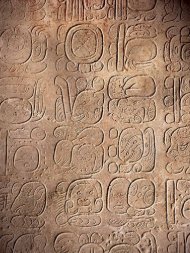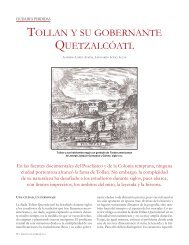A Late Preclassic Distance Number - Mesoweb
A Late Preclassic Distance Number - Mesoweb
A Late Preclassic Distance Number - Mesoweb
Create successful ePaper yourself
Turn your PDF publications into a flip-book with our unique Google optimized e-Paper software.
Giron-Ábrego<br />
“5.” 5<br />
pA4<br />
Figure 5. Division of<br />
glyph compound pA4<br />
into affixes. Drawing by<br />
David Stuart.<br />
Prefix<br />
Subfix<br />
Superfix<br />
Main Sign<br />
The pedestal-like subfix would categorize the<br />
glyph compound as a unit of time, a katun in<br />
this case, but not meant to be read phonetically,<br />
similar to the subfix on the Dumbarton Oaks<br />
Jade Celt (B2).<br />
If pA3 indeed records “on (the) fifth katun,” it would<br />
suggest that the PE on the San Bartolo block falls on<br />
7.5.0.0.0 (255 bc).<br />
In my earlier paper, I also suggested that block pA4<br />
in the San Bartolo text (the focus of this paper) may have<br />
served a similar syntactical function as block A3 on the<br />
Dumbarton Oaks Jade Celt (Figure 4), noting some<br />
graphic similarities between the two glyph blocks and<br />
observing that both compounds are still undeciphered.<br />
Fields and Tokovinine (2012:188) have recently<br />
suggested that the PE clause on the Dumbarton Oaks<br />
Jade Celt (A1-B2) is self-containing, and that A3 may<br />
represent the beginning of a new sentence (or clause),<br />
perhaps providing an underspelled verb, or a stative<br />
construction such as “it is,” “there is,” etc.<br />
Along a similar line of thought, I propose that pA4<br />
functions as a transition between two distinct clauses. As<br />
I discuss below, its prefix and superfix might represent<br />
numbers, hence the suggestion that it may represent a<br />
DN. As is well known, DNs can occur after PE clauses<br />
in order to move the narrative forwards or backwards<br />
in time (Kettunen and Helmke 2011:50; Thompson<br />
5<br />
If so, the lack of a glyph for katun itself would perhaps<br />
correspond with the way the earliest contemporaneous Long Count<br />
dates are recorded on monuments such as Chiapa de Corzo Stela<br />
2, Tres Zapotes Stela C, El Baúl Stela 1, Takalik Abaj Stelae 2 and 5,<br />
La Mojarra Stela 1, and the Tuxtla Statuette, where the units of time<br />
are represented only by their corresponding numerical coefficient.<br />
1950:157-180). To pursue this line of thought, I’ve<br />
subdivided block pA4 into units corresponding to our<br />
understanding of Classic Period DNs (Figure 5).<br />
The potential prefix apparently consists of two<br />
dots. Rather than the syllable-doubling diacritic (not<br />
otherwise attested until the fourth century ad), these<br />
dots are suggestive of the coefficient “2,” following the<br />
pervasive bar and dot notation of Maya hieroglyphs<br />
(Thompson 1950:130-131). The superfix, where a second<br />
number would usually be expected in a Classic Period<br />
DN, apparently extends over both the main sign and<br />
the prefix. It does not appear to fall into the bar and dot<br />
numerical classification. Instead, its overall shape is a<br />
silhouette of two squared arches with rounded corners<br />
and a smaller detail infixed between the two. Bearing in<br />
mind the logosyllabic diversity that corresponds to the<br />
“zero” in Maya writing (Blume 2011), I suggest that this<br />
may represent either a calligraphic variant or an early<br />
allograph of T173, perhaps presenting only a portion of<br />
its full form in the pars pro toto principle (Coe 1976). T173<br />
is of course commonplace in Classic Period texts, where<br />
it can be read as MIH/mi “zero.” It is employed as the<br />
number zero in calendrical and mathematical instances,<br />
and as a syllable and negative marker in word formation<br />
contexts (Blume 2011; Grube and Nahm 1990).<br />
The subfix, although almost entirely erased, may<br />
simply be a complementary part of the rectangular main<br />
sign, without qualities that are meant to be read phonetically,<br />
but perhaps identifying the glyph compound<br />
as a unit of time as in the case of the proposed katun<br />
sign.<br />
The main sign is unfortunately rather obscure. Its<br />
internal features include only a central triangle with<br />
a dot to its left and a small horizontal line to its right.<br />
Nonetheless, I am inclined to contemplate that it represents<br />
a suppressed glyph for a unit of time, such as the<br />
“kin-uinal” combination well-known in Classic Period<br />
DNs. In the majority of kin-uinal combinations, the kin<br />
glyph is suppressed and is only inferred by the presence<br />
of its coefficient (Thompson 1950:159). As a general rule,<br />
…the winik coefficient only takes the same space horizontally<br />
or vertically as the winik sign, whereas the k’in coefficient<br />
occupies the whole extent (length or vertical space)<br />
of the remaining glyph block. A worthy piece of advice is<br />
to look at the upper left corner of the glyph block: whatever<br />
number occupies that position is the coefficient of the<br />
k’in period. (Kettunen and Helmke 2011:54)<br />
Assuming these <strong>Late</strong> Classic conventions can be traced<br />
back to a significantly earlier period, the numerical<br />
10


